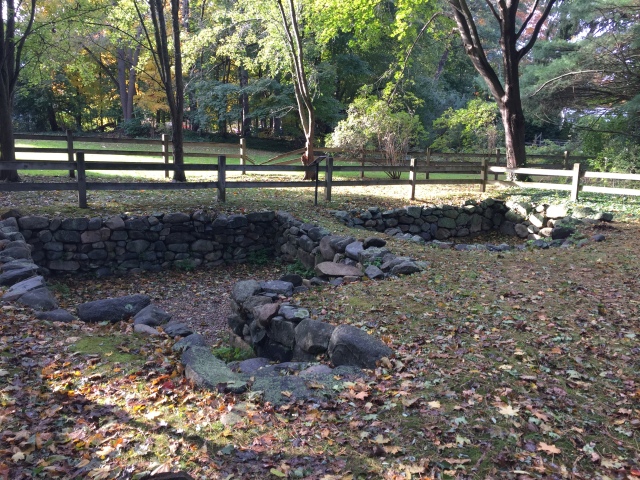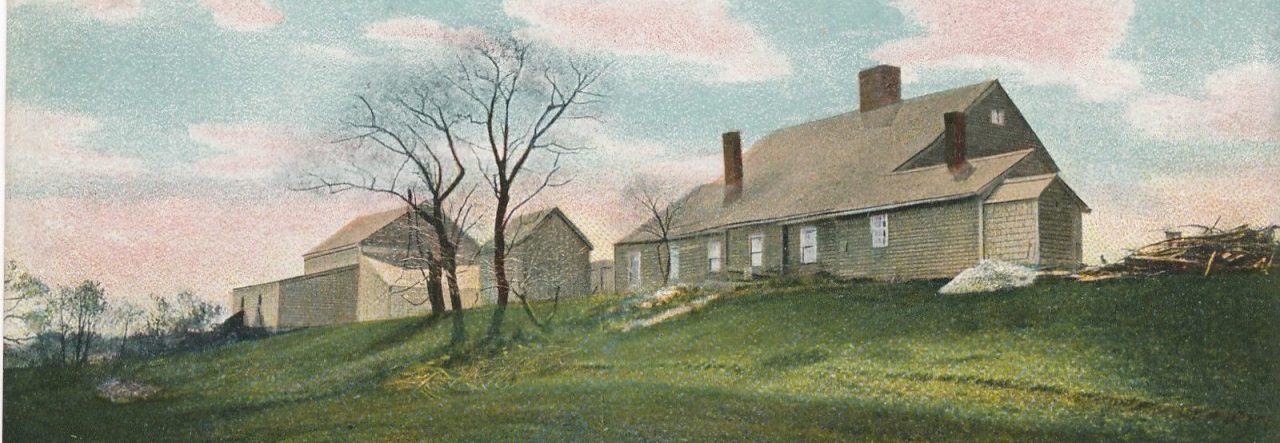(In the Herald-Citizen, 11/15/2019)

(The parsonage foundation. Author’s photo).
During the winter of 1691-1692, the house grew cold as the stockpile of wood dwindled and snow piled up outside. The Salem Village minister, Rev. Samuel Parris was not being paid as promised. Worse, his claim of ownership to the parsonage, the house in which he and his family lived while he was minister of the church in Salem Village (present-day Danvers), was disputed. The minister and his family were very anxious about their future.
The stuffy air inside the house was punctuated by a shriek, then two, before the scraping of furniture on the wooden floor was heard as Betty Parris, the minister’s daughter, crawled under tables and chairs, still screaming. Soon, Rev. Parris’ niece Abigail Williams joined in too. Something frightening was happening in Salem Village.

(The only known image of Rev. Samuel Parris, Massachusetts Historical Society: http://www.masshist.org/database/3732).
The Salem Village parsonage was ground zero for the 1692 Salem Village Witch-Hunt, during which almost 200 innocent people were accused of witchcraft – the impossible crime of signing a contract with the Devil in return for supernatural powers. Nineteen were hanged, one was pressed to death, and at least five died in jail. The chaos began with the two girls in the minister’s household having so-called “fits,” during which they screamed, contorted, and claimed that they were being attacked by specters – ghostly images of the alleged witches. Not long after these fits began in the parsonage, young women, middle-aged women, and adult men across Salem Village began acting similarly, and Parris’ Caribbean slave Tituba was the first accused of witchcraft.
Several years prior to the witch-hunt, Rev. Parris was hired as the minister in Salem Village, in the hope that he could calm a community that had fought contentiously with its previous ministers – disputes that grew serious enough to involve the courts, the Massachusetts legislature, and surrounding churches.
Though, calm was elusive. Several Villagers showed their disapproval of the new minister by withholding their taxes, which were used to pay his salary. For his part, Parris undermined the calm by apparently attempting to change the terms of his contract only months after being hired. As was typical, he was given the use of the 1681 parsonage building while he served as minister, though it remained owned by the community.
But, Parris wanted ownership of the house. A merchant in Boston and landholder in Barbados prior to coming to Salem Village, he sought the economic security that came with land ownership. His supporters organized either a secret town meeting, or at least a very poorly-attended one, that voted to give Parris ownership of the parsonage house. When this deception was revealed in the months before the witch-hunt, it caused anger across Salem Village.
During the witch-hunt, Parris testified against several of the innocent accused including Rebecca Nurse, whose family farm remains on Pine St. in Danvers. After the witch-hunt, Nurse’s family fought to remove Parris as the Village minister due to his role in the witch-hunt. The family wrote of Parris in a later court document, “Mr. Parris, by these practices and principles, has been the beginner and procurer of the sorest afflictions, not of this village only, but to this whole country, that ever did befall them.” Parris was forced out in 1697 finally ending his controversial tenure as minister. Prior to his departure, his wife Elizabeth passed away and was buried in what is now the Wadsworth Cemetery on Summer St.

(Photograph of Elizabeth Parris’ headstone, 2019. Author’s photo).
Subsequent Village ministers lived in the parsonage for almost a century. When Rev. Peter Clark was the minister during the mid-1700s, his young neighbor Samuel Holten lived with the minister and his family in the parsonage so that he could be tutored by Clark. Holten went on to become a judge, member of the Continental Congress, and signer of the Articles of Confederation. He served temporarily as President of Congress under the Articles and later became a member of the U.S. Congress after the Constitution was ratified.
The original 1681 parsonage was torn down in 1784, with a newer section of the house moved to a different location. Rev. Benjamin Wadsworth replaced it with a grand new Georgian house for the ministry, what is today 73 Centre St. Meanwhile, the original parsonage site was abandoned, the cellar holes were filled in, and it was used as a field for grazing horses. Over time, the exact location of the site was lost to history.

(A photograph from 1891 of what was believed to be the area of the 1681 parsonage site. Frank Cousins, Danvers Site of Reverend Samuel Parris House, 1891, Frank Cousins Collection of Glass Plate Negatives. Courtesy of Phillips Library, Peabody Essex Museum, Salem, MA).

(The new 1784 Parsonage, 73 Centre St., Danvers as seen c. 1891. Frank Cousins, Danvers, Centre Street, Wadsworth house, c.1891, Frank Cousins Collection of Glass Plate Negatives, 606. Courtesy of Phillips Library, Peabody Essex Museum, Salem, MA).
It was not until the early 1970s that then-Curator of the Danvers Historical Society Richard B. Trask, along with members of the Society, the town Historical Commission, and other interested locals began a search for the parsonage site. After using the 17th century Salem Village Record Book, along with 18th century maps, the probable site was located in the yard of Alfred Hutchinson, a local teacher. Partnering with archaeologist Roland Wells Robbins, whose prior work included Thomas Jefferson’s birthplace, Thoreau’s cabin at Walden Pond, and the Saugus Iron Works, the site was investigated and stone foundations were found.
Hutchinson permitted the excavation of this section of his yard, and about a dozen volunteers worked tirelessly on the site. As the stone foundation was uncovered, more than 30,000 artifacts were discovered, including 17th and 18th century coins, cutlery, pipe bowls from the 1660s, a metal plate bearing the initials of Samuel and Elizabeth Parris, and many wine bottle fragments, some of which had Parris’ initials on them.
The more that was found, the greater the interest and the need for volunteers. The original volunteers were joined in Hutchinson’s backyard by hundreds of locals who helped sift, dig, and sort found items. This excavation became a community effort that yielded significant finds from one of the most important sites in colonial American history.
Today, the site is town-owned and open to the public via a cart path next to 67 Centre St. Possibly the most photographed site in Danvers, the parsonage cellars are featured in many history books, and frequently appear on television programs about the witch-hunt.

(Sign at 67 Centre St.)

(Path from the parsonage site to the street).



—————————————————————————————————-
Sources
Boyer, Paul, and Stephen Nissenbaum, eds. Salem Village Witchcraft: A Documentary Record of Local Conflict in Colonial New England. Boston: Northeastern University Press, 1993.
First Church of Danvers Congregational. Church Record Book Belonging to Salem Village, 1689-1845.
Gragg, Larry. A Quest for Security: The Life of Samuel Parris, 1653-1720. New York: Greenwood Press, 1990.
McKern, Sharon S. “They’re Digging up Witch Lore in Salem.” Science Digest, May 1971.
Salem Village. “A Book of Record of the Severall Publique Transactions of the Inhabitants of Salem Village Vulgarly Called The Farmes.” Edited by Harriet S. Tapley. Historical Collections of the Danvers Historical Society 13 (1925): 91–122; 14 (1926): 65-99; 16 (1928): 60-80.
Trask, Richard B. “History of the Salem Village Church Record Book.” Danvers Archival Center at the Peabody Institute Library, September 15, 2015. https://www.danverslibrary.org/archive/village-church-record-book/.
Trask, Richard B. “Raising the Devil.” Yankee Magazine, May 1972.

Excellent article!
LikeLike
Thanks!
LikeLike
Thank you!!
LikeLike
Trifecta of interests for me; archaeology, family genealogy, and religion.
LikeLike